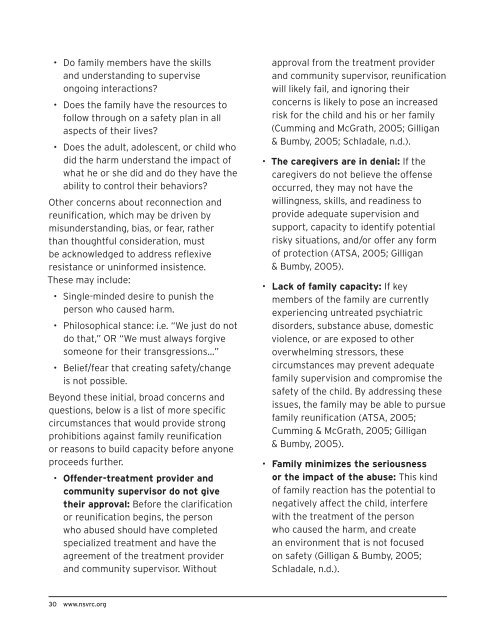Considering Family Reconnection and Reunification after Child Sexual Abuse
1VwGeds
1VwGeds
Create successful ePaper yourself
Turn your PDF publications into a flip-book with our unique Google optimized e-Paper software.
• Do family members have the skills<br />
<strong>and</strong> underst<strong>and</strong>ing to supervise<br />
ongoing interactions?<br />
• Does the family have the resources to<br />
follow through on a safety plan in all<br />
aspects of their lives?<br />
• Does the adult, adolescent, or child who<br />
did the harm underst<strong>and</strong> the impact of<br />
what he or she did <strong>and</strong> do they have the<br />
ability to control their behaviors?<br />
Other concerns about reconnection <strong>and</strong><br />
reunification, which may be driven by<br />
misunderst<strong>and</strong>ing, bias, or fear, rather<br />
than thoughtful consideration, must<br />
be acknowledged to address reflexive<br />
resistance or uninformed insistence.<br />
These may include:<br />
• Single-minded desire to punish the<br />
person who caused harm.<br />
• Philosophical stance: i.e. “We just do not<br />
do that,” OR “We must always forgive<br />
someone for their transgressions…”<br />
• Belief/fear that creating safety/change<br />
is not possible.<br />
Beyond these initial, broad concerns <strong>and</strong><br />
questions, below is a list of more specific<br />
circumstances that would provide strong<br />
prohibitions against family reunification<br />
or reasons to build capacity before anyone<br />
proceeds further.<br />
• Offender-treatment provider <strong>and</strong><br />
community supervisor do not give<br />
their approval: Before the clarification<br />
or reunification begins, the person<br />
who abused should have completed<br />
specialized treatment <strong>and</strong> have the<br />
agreement of the treatment provider<br />
<strong>and</strong> community supervisor. Without<br />
approval from the treatment provider<br />
<strong>and</strong> community supervisor, reunification<br />
will likely fail, <strong>and</strong> ignoring their<br />
concerns is likely to pose an increased<br />
risk for the child <strong>and</strong> his or her family<br />
(Cumming <strong>and</strong> McGrath, 2005; Gilligan<br />
& Bumby, 2005; Schladale, n.d.).<br />
• The caregivers are in denial: If the<br />
caregivers do not believe the offense<br />
occurred, they may not have the<br />
willingness, skills, <strong>and</strong> readiness to<br />
provide adequate supervision <strong>and</strong><br />
support, capacity to identify potential<br />
risky situations, <strong>and</strong>/or offer any form<br />
of protection (ATSA, 2005; Gilligan<br />
& Bumby, 2005).<br />
• Lack of family capacity: If key<br />
members of the family are currently<br />
experiencing untreated psychiatric<br />
disorders, substance abuse, domestic<br />
violence, or are exposed to other<br />
overwhelming stressors, these<br />
circumstances may prevent adequate<br />
family supervision <strong>and</strong> compromise the<br />
safety of the child. By addressing these<br />
issues, the family may be able to pursue<br />
family reunification (ATSA, 2005;<br />
Cumming & McGrath, 2005; Gilligan<br />
& Bumby, 2005).<br />
• <strong>Family</strong> minimizes the seriousness<br />
or the impact of the abuse: This kind<br />
of family reaction has the potential to<br />
negatively affect the child, interfere<br />
with the treatment of the person<br />
who caused the harm, <strong>and</strong> create<br />
an environment that is not focused<br />
on safety (Gilligan & Bumby, 2005;<br />
Schladale, n.d.).<br />
30 www.nsvrc.org


